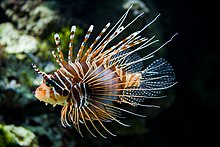Lionfish (disambiguation): Difference between revisions
| Line 8: | Line 8: | ||
== Native environment == |
== Native environment == |
||
The lionfish is native to the tropical Indo-Pacific region of the world, but various species can be found worldwide. Due to a recent introduction, the lionfish has recently been spotted in the warmer coral regions of the Eastern [[Atlantic Ocean]] and [[Caribbean Sea]].<ref>{{cite journal |author=Whitfield, P; Gardner, T; Vives, SP; Gilligan, MR; Courtney Jr, WR; Ray, GC; Hare, JA |title=The Introduction and Dispersal of the Indo-Pacific Lionfish (Pterois volitans) Along the Atlantic Coast of North America |journal=In: SF Norton (ed). Diving for Science...2003. |volume=Proceedings of the American Academy of Underwater Sciences |issue=22nd Annual Scientific Diving Symposium |date=2003 |url=http://archive.rubicon-foundation.org/4766 |accessdate=2008-08-13 }}</ref> Lionfish are an [[invasive species]] in the Atlantic Ocean and the Caribbean Sea regions. <ref>[http://www.nytimes.com/2006/09/08/nyregion/08fish.html Bruce Lambert, "A Spiny Invader Proliferates in L.I. Waters, and Scientists Wonder About Its Impact", - New York Times (September 8, 2006)]</ref> Successful breeding of the lionfish in captivity has not been looked upon. |
The lionfish is native to the tropical Indo-Pacific region of the world, but various species can be found worldwide. Due to a recent introduction, the lionfish has recently been spotted in the warmer coral regions of the Eastern [[Atlantic Ocean]] and [[Caribbean Sea]].<ref>{{cite journal |author=Whitfield, P; Gardner, T; Vives, SP; Gilligan, MR; Courtney Jr, WR; Ray, GC; Hare, JA |title=The Introduction and Dispersal of the Indo-Pacific Lionfish (Pterois volitans) Along the Atlantic Coast of North America |journal=In: SF Norton (ed). Diving for Science...2003. |volume=Proceedings of the American Academy of Underwater Sciences |issue=22nd Annual Scientific Diving Symposium |date=2003 |url=http://archive.rubicon-foundation.org/4766 |accessdate=2008-08-13 }}</ref> Lionfish are an [[invasive species]] in the Atlantic Ocean and the Caribbean Sea regions. <ref>[http://www.nytimes.com/2006/09/08/nyregion/08fish.html Bruce Lambert, "A Spiny Invader Proliferates in L.I. Waters, and Scientists Wonder About Its Impact", - New York Times (September 8, 2006)]</ref> Successful breeding of the lionfish in captivity has not been looked upon. |
||
.,k |
|||
== Size == |
== Size == |
||
Revision as of 15:44, 28 September 2008



A Lionfish is any of several species of venomous marine fish in the genera Pterois, Parapterois, Brachypterois, Ebosia or Dendrochirus, of the family Scorpaenidae. The lionfish is also known as the Turkey Fish, Dragon Fish or Scorpion Fish.[1] They are notable for their extremely long and separated spines, and have a generally striped appearance, red, brown, orange, yellow, black, maroon, or white.
Native environment
The lionfish is native to the tropical Indo-Pacific region of the world, but various species can be found worldwide. Due to a recent introduction, the lionfish has recently been spotted in the warmer coral regions of the Eastern Atlantic Ocean and Caribbean Sea.[2] Lionfish are an invasive species in the Atlantic Ocean and the Caribbean Sea regions. [3] Successful breeding of the lionfish in captivity has not been looked upon.
.,k
Size
The common lionfish generally reaches a size of 30-35cm. Smaller lionfish (e.g., the Fuzzy Dwarf) are typically the size of a tennis ball (not including fins). There are many types of lionfish that vary in size.
Venom
Lionfish have venomous spines that are deadly to their prey, but usually not to humans (though the venom is used purely for defense, not attack). If a human is envenomated, that person will experience severe pain and possible headaches and vomiting. A common treatment is soaking the afflicted area in hot water, as very few hospitals carry specific treatments.[4][5][6] However, immediate emergency medical treatment is still advised, as some people may be more susceptible to the venom than others.
Feeding
Lionfish are voracious predators. When hunting, they corner prey using their large fins and then use their quick reflexes to swallow the prey whole. In captivity, lionfish can be trained to eat frozen brine shrimp, mysis, and krill.
References
- ^ Mike McEwan, "A Fierce Predator: When the Lionfish shows its aggressive looks, its no bluff", Aquaria Central
- ^ Whitfield, P; Gardner, T; Vives, SP; Gilligan, MR; Courtney Jr, WR; Ray, GC; Hare, JA (2003). "The Introduction and Dispersal of the Indo-Pacific Lionfish (Pterois volitans) Along the Atlantic Coast of North America". In: SF Norton (ed). Diving for Science...2003. Proceedings of the American Academy of Underwater Sciences (22nd Annual Scientific Diving Symposium). Retrieved 2008-08-13.
{{cite journal}}: CS1 maint: multiple names: authors list (link) - ^ Bruce Lambert, "A Spiny Invader Proliferates in L.I. Waters, and Scientists Wonder About Its Impact", - New York Times (September 8, 2006)
- ^ Aldred B, Erickson T, Lipscomb J (1996). "Lionfish envenomations in an urban wilderness". Wilderness Environ Med. 7 (4): 291–6. PMID 11990126.
{{cite journal}}: Unknown parameter|month=ignored (help)CS1 maint: multiple names: authors list (link) - ^ Taylor, G. (2000). "Toxic fish spine injury: Lessons from 11 years experience". South Pacific Underwater Medicine Society journal. 30 (1). ISSN 0813-1988. OCLC 16986801. Retrieved 2008-08-13.
- ^ Vetrano SJ, Lebowitz JB, Marcus S (2002). "Lionfish envenomation". J Emerg Med. 23 (4): 379–82. PMID 12480019. Retrieved 2008-08-13.
{{cite journal}}: Unknown parameter|month=ignored (help)CS1 maint: multiple names: authors list (link)
